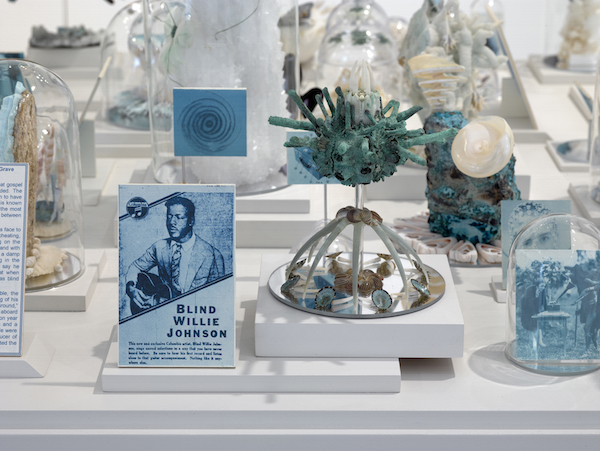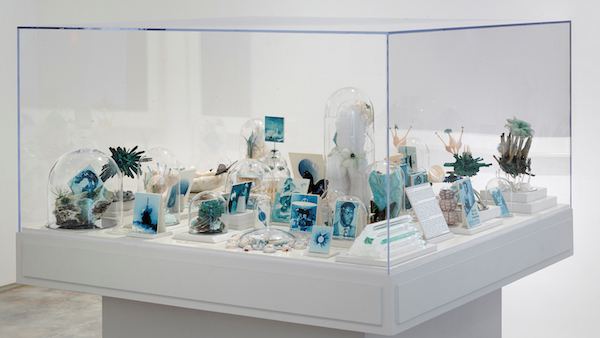Cara Ober on Dario Robleto: Setlists for a Setting Sun at the Baltimore Museum of Art
You know it’s working when the total is greater than the sum of its parts.
In the BMA’s Contemporary Front Room Gallery, Dario Robleto: Setlists for a Setting Sun challenges this notion with odd conglomerations of such highly specific materials that it’s impossible not to become stuck on tangent after tangent. Like a color coordinated cabinet of curiosity, Robleto’s assemblages at the Baltimore museum function simultaneously as sculpture, curated science diorama, and history lesson, reminding us of the distinctive power of things – from visual, emotional, and historical perspectives.
There’s a lot going on in American Seabed, the exhibition’s central square tableau, full of repetitive, oblong shell-shapes and taxidermied butterflies on top of dozens of individual concrete bases. Underneath, white tentacles of coral reach out like dead fingers from the sea. After bending down to get a better look at the coral, you notice the gray concrete blocks are stained with washes of blue-green, somehow softening the structures and imprinting them with a natural history. The piece is a meditation on nature and biology, but it’s not until you read the list of materials that it becomes truly magical.
Media includes: “fossilized prehistoric whale ear bones salvaged from the sea (1 to 10 million years), various butterflies, butterfly antennae made from stretched and pulled audiotape recordings of Bob Dylan’s “Desolation Row,” concrete, ocean water, pigments, coral, brass, steel, and Plexiglas.”
There’s something about the experience of looking at this thing as a whole, and then attempting to identify each part, that enhances your read of Seabed. The list of weird clues transforms you into a detective, and you become an active part of the piece, attaching your own theories on the sea, fossils, nature, evolution, extinction, industrial materials, and, of course Bob Dylan, into a unique narrative that values your own understanding of each topic.
While you’re constructing the story, something interesting happens: you begin to see each separate ingredient, really see it, and become more curious about the arrangement and metaphorical value of each. You begin to appreciate the innate beauty of each mysterious bone, each iridescent butterfly wing, and each crusty vein of coral. The artwork comes completely apart as you unpack it in your mind, but the odd mystery of its synthesis brings it back together. Like most of the other works included in this exhibit, American Seabed manages to function simultaneously as a cohesive whole and a collection of eclectic parts, and it’s this dichotomy between literal and poetic meaning that imbues this show with an odd and wonderful magic.
There are two other square tableaus in Setlists, and both feature dozens of tiny, color coordinated objects arranged to delight the eye and mine historical, natural, and political themes.
Although not placed next to each other, these two works function as twins, not exactly one work and not separate, either. Titled Setlists for a Setting Sun (Dark Was the Night) and Setlists for a Setting Sun (The Crystal Palace), both works feature tiny prints and cyanotypes and a cerulean blue color that manages to be warm and lively, like a tropical ocean, as well as butterflies with altered antennae, cave minerals and homemade crystals, “black swan vertebrae, lapis lazuli, coral, sea urchin shells, sea urchin teeth, various seashells, ocean water, pigments, cut paper, mica flakes, glitter, feathers, colored mirrors, plastic and glass domes, audio recording, digital player, headphones, wood, and polyurethane.”

Sea urchin teeth? Glitter? Black swan vertebrae? Just let that list sink in and then add two live musical recordings that inform the theme of each case with headphones to take a listen while you look: The Crystal Palace Recordings of Handel’s “Israel in Egypt,” from 1888, the world’s oldest live recording of a musical performance, and Blind Willie Johnson’s “Dark Was the Night,” recorded 1927, a song that was part of a collection of music compiled by Carl Sagan and launched into space on the unmanned Voyager 1 probe in 1977.
Robleto’s multisensory tactics allow you to approach the disparate parts of each table uniquely while helping to build a thematic understanding from all different directions. Both musical recordings are emotionally moving and their influence, as well as a general appreciation for the historical importance of live music, enriches and deepens the experience of the two Setlists. These works in particular offer so many different contrasting items they never settle into resolution and this seems honest, mimicking the beautiful confusion of life rather than colonizing it.
With the exception of a tiny, pseudo-scientific display of human hand bones, actually fashioned from the artist’s melted down record albums, and a wall display of mason jars, crystals, and altered butterflies, the other works in this show are two-dimensional and displayed in series on the wall.
More simplistic compared to the central sculptures, Life, Left to Struggle in the Sun explores the legacy of deceased artists through the doodles they have left behind. Robleto interprets these sketches, handwritten lyrics, and poems with scratch-outs and edits by writers, pop stars, and poets as a 16-part cyanotype.
Called ‘ghost images,’ which is a poetic way of saying appropriation, the images were culled from a fascinatingly random yet specific list that includes Keats, Cobain, Marley, Proust, Cash, Shakur, Lennon, and others. Their materials include “sunlight, chlorophyll, and ocean water” on watercolor paper and each sports subtle washes of blue-green, which ties it visually to other works in the room.

The back wall of the gallery functions as the anchor for the show and features a suite of eight large digital prints titled The Sky, Once Choked With Stars, Will Slowly Darken. The images appear to be romantic, overexposed photos of street lights at night, but the wall text reveals a much more clever and interesting theme.
Each was captured directly from a live album cover – they are the stage lights behind Johnny Cash on “Live at San Quentin,” behind John Coltrane on “The Paris Concert,” and from six other well known pop, jazz, and blues artists’s albums. This idea and its execution is infinitely simpler than the curated sculptural tableaus in the center of the gallery, but it serves as an elegant balancing agent. I’m not sure if one of these images could stand alone as successfully, but it would be fun to try and see – the dark, velvety paper and romance of the light flares present a dramatic moment that is only enhanced by their music nostalgia.
The last body of work included in this show is not really worth mentioning, except that it would have been better left out. On a side wall there are three mixed media collage faux album covers made from cut paper, colored pencil, and foam core and they look like they were produced for a middle school homework assignment. Although they’re clever, in that these albums were designed for imaginary, highly specific groups of scientists, and offer a chuckle, these works are visually lacking and merely cute. They possess none of the subtlety of the rest of the show and don’t offer insight into the other works. When you go, just avoid these and pretend you didn’t see them! They’re fairly small, so this should be easy to do.
Although the range of specific objects in Setlists may initially seem mystifying and random, and may baffle some visitors to the museum (“So what IS this stuff?” I heard a woman ask her husband in a grumpy voice as they strolled through), Dario Robleto’s Setlists for a Setting Sun is a richly rewarding experience for anyone who can commit to looking with an even average attention span. The exhibit is a trove of visual delight that is only enhanced by the musical themes threaded throughout.
I found myself thinking, “Yes! This!” and smiling giddily while I looked and listened, feeling inspired by the artist’s affirmation of life, nature, and the universality of human longing. I felt gratified that Robleto chose popular culture, and especially popular music, as well as natural biological samples, as a way to communicate ideas of reverence, making his message universally appealing to include even children and those without degrees in critical theory.
According to the BMA’s press materials, Robleto considers himself a “materialist poet” and the moniker makes perfect sense. Not only is the artist an obsessive collector of breath-taking ephemera, his ability to synthesize disparate items based on their propensity for allusion and metaphor imbues them with power. There’s so much to absorb from this exhibit and it can be overwhelming, but it’s really a gift. Each piece and layer of Robleto’s Setlists is achingly rich, blending into a whole that is fractured, but in the best way.
Dario Robleto: Setlists for a Setting Sun will be on view at the BMA through March 29, 2015.
Hear the artist discuss the cross-pollination of art and science at the the Space Telescope Science Institute (STScl) on the campus of The Johns Hopkins University on Tuesday, March 3.
Author Cara Ober is founding editor at BmoreArt.









